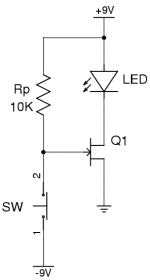Quote:
| I want to make it so that if a headphone plug is inserted an LED light turns on indicating it. Is there an easy way to do this? |
I just hacked this circuit out:
SW is a normally-closed switch. Many headphone jacks have two of these built in which you probably aren't using, so we're going to use one of them to control the LED. Q1 is a small JFET, configured such that the n/c switch connects the gate to V- in the amp, pulling it below the source, which is at [virtual] ground. This cuts off current through the JFET. When the switch opens due to inserting the headphone jack, the 10K pullup resistor (Rp) brings the gate above the source, saturating the JFET, bringing the LED on. 10K is a random value I picked out of the air that should work, but 100K is more efficient and should still work.
Several things to beware of. First, check your JFET's spec sheet to see what the maximum Vdg voltage is. The one I'm using (2N5484) is 25V; since the gate can be as low as V- in this setup and drain is at V+ less the drop of the LED, this means you can only use this circuit with up to 27V on the power supply, if your LED has a 2V drop. Play it safe and don't use it on supplies higher than 24V, or get a JFET capable of tolerating a higher Vdg difference. Alternately, you can put a resistor inline with the n/c switch to form a divider such that the gate doesn't go all the way to V-. Another thing to beware of is that the JFET is used in saturation, which means you need a JFET with a small enough Idss that the LED isn't too bright or burning up. If you can't find a suitable JFET or you want to tune the brightness, you'll need to add a source resistor.
Have fun with this!
Quote:
| Also, how do momentary switches/buttons work? |
The keys on your keyboard are momentary switches. Holding the actuator (button, bat, whatever) down opens or closes the contact (depending on the switch type), and releasing the actuator returns it to the normal state.
Quote:
| I saw some very nice buttons but they are all momentary and would like to configure it for use with an amp's power on/off function. |
As you can see, these are not the right kind of switches for power, in and of themselves. You'd have to lash up a relay or a transistor circuit to do what you want.


